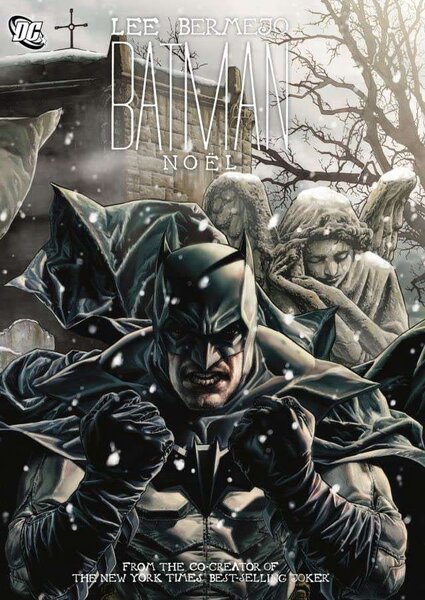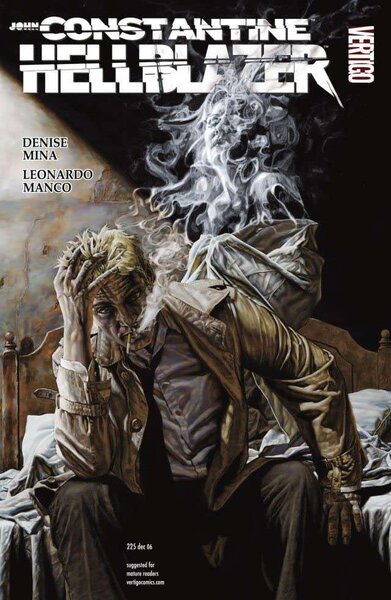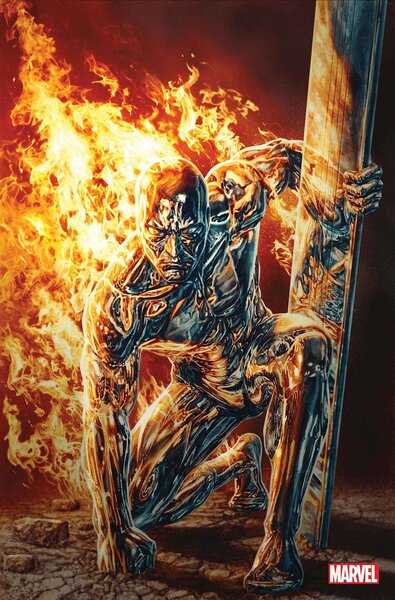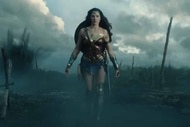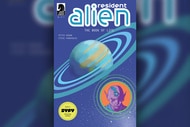Create a free profile to get unlimited access to exclusive videos, sweepstakes, and more!
All-star artist Lee Bermejo on new DC coffee table book, the Batsuit, and his favorite cover
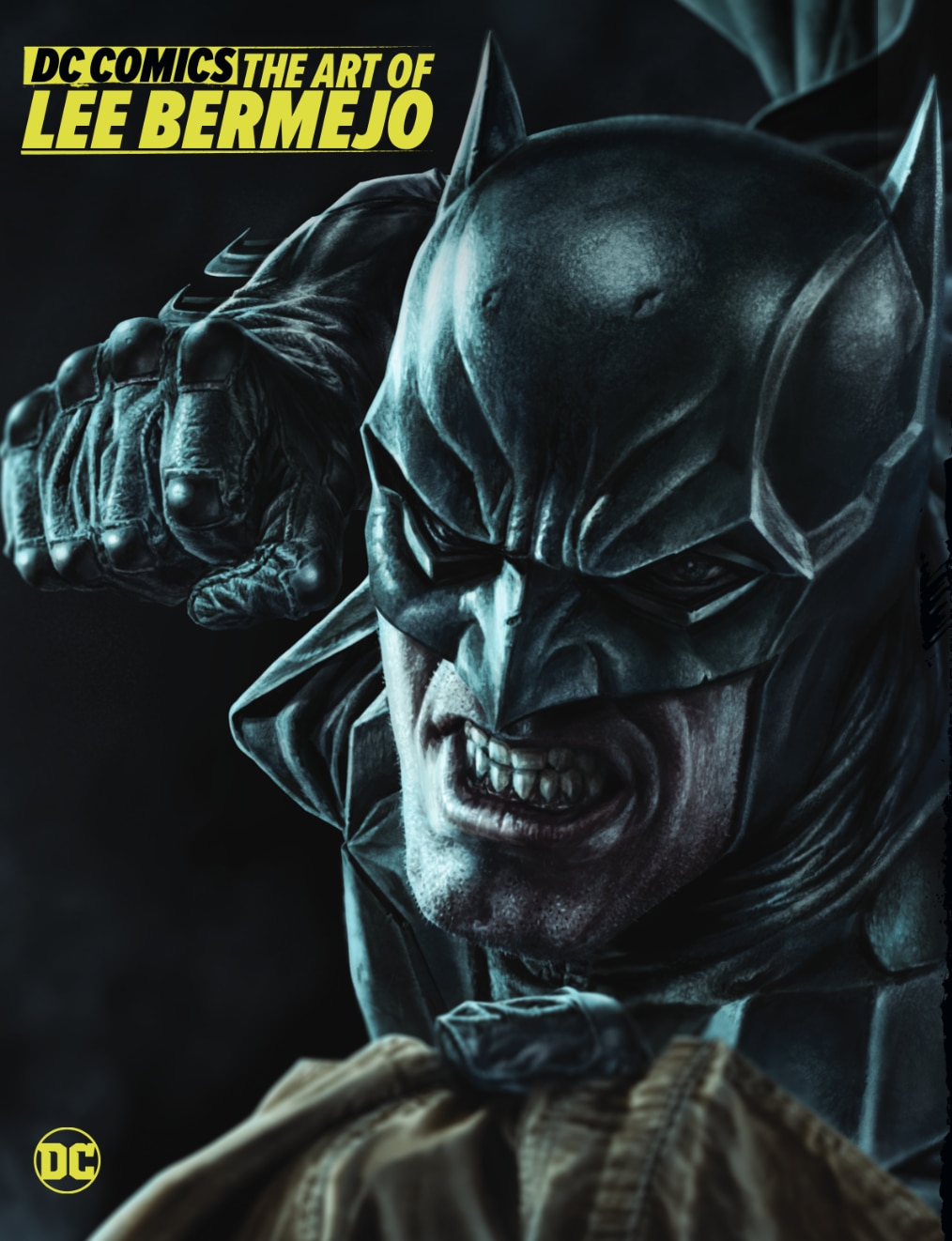
There are perhaps just a handful of modern comic artists whose work is so instantly recognizable, one doesn't even need to look at the credits to know who drew it. Lee Bermejo is without question a member of that exclusive club. After all, there is no modern-day artist who draws a more distinctive Dark Knight than Bermejo.
The artist's pencil-and-ink wash greatness is on full display in a brand new coffee table collection, DC Comics: The Art of Lee Bermejo. It features some of the most striking examples from Bermejo's career including Joker, Lex Luthor: Man of Steel, and Suiciders –– along with some of the stunning cover images he's done over the years for DC and Vertigo Comics. And Bat-fans need not worry. There is plenty of Caped Crusader art in this book, including memorable images from Batman: Noel, Batman/Deathblow, and the oh-so-controversial Batman: Damned. Indeed, during his nearly two decades of work at DC, Bermejo has established himself as one of the defining Bat-artists of the 21st century.
His photo-realistic rendition of Batman gives the character a street-level perspective that virtually no other artist has been able to deliver. Bermejo's version of his costume, with its tactical sensibilities, slightly baggy pants, and buckles, is not a superhero costume: it's gear designed for urban warfare. There has been much speculation that the Batsuit Robert Pattinson wears in The Batman draws much inspiration from Bermejo's costume design. And if you've seen the teaser trailer, it's hard not to see the similarities between the suit in Matt Reeves' movie and the artist's version.
While Bermejo stresses he's had no conversations with Reeves or anyone connected with the upcoming movie, he does see the same visual connections to his design that many others see.
"Yeah, there's definitely stuff that looks familiar. When I saw the first pictures of the stunt guy, I thought, ‘Oh my God, that really looks like my [costume design],'" Bermejo tells SYFY WIRE from his home in Italy (because a guy who draws so well is almost required to live in Italy, right?). "Not exactly, but the thought process is the same where he's wearing kind of like urban combat gear, you know what I mean? And when I saw the utility belt and he had kind of the hooks on the utility belt and the kind of angular sectioning of the chest piece and even the pants being slightly baggy or not the tight spandex kind of pants, and they have kind of the armored sections on them and stuff. There's a lot about that, that when I first saw it, I thought, 'Wow.' That in fact, I love it. I think it looks awesome."
Bermejo notes that comic book movies often cherry-pick various elements to assemble the filmmaker's vision, and he sees Reeves following the same pattern.
"With these kinds of projects, very few of these filmmakers will call out exactly the individual inspirations. They'll stick to kind of the bigger ones. And so I know Matt Reeves talks a lot about Darwyn Cooke’s Ego and Jeph Loeb and Tim Sale's The Long Halloween as his big inspirations. But when I look at the Batman Pattinson is playing, he doesn't look like Tim Sale’s Batman. So I'm really excited. I think that the movie looks excellent and it's the closest thing I've seen to my Batman onscreen, so that that's cool."
Not that a guy with multiple New York Times bestseller credits needs it, but the new coffee table book serves as a confirmation as much as it is a celebration of a tremendous body of work. Assembled by DC's french licensor Urban Comics, Bermejo says that at first he was hesistant to do it.
"They wanted to do this chronological structure, which at first I wasn't even on board with because I didn't want to show the early years stuff; [i think] it's kind of embarrassing," he says. "But it was the brainchild of an editor at Urban, Sarah Chantepie, and she wore me down and eventually I understood why she wanted to show [the early work]. When I pick up an Adam Hughes book and I see some of those early covers that he did compared to some of the stuff that he's doing now, you can kind of see the artist evolving over time. And Sarah really wanted to showcase that part of the process."
Looking back at one's career can be a nostalgic but cringe-inducing journey for many artists. Artistic styles change, and revisiting early work often leads to pencillers seeing only the mistakes and none of the magic. While assembling his career retrospective, Bermejo experienced some of this, but he also admits to being reminded of some of the great imagery he created that made him an industry star in the first place. When asked to pick out a standout image from the book, it was a bit surprising to hear him select not an image from his signature character, a certain Caped Crusader, but a portrait of John Constantine. It was his stunning cover artwork for Vertigo's Hellblazer series that first turned fans on to Bermejo's vivid pencil work in the early 2000s.
"There is a Hellblazer cover [issue #225] that is still my favorite drawing I've ever done," he says. "It’s Constantine sitting on a bed and he's smoking a cigarette and behind him, the smoke kind of uncovers a ghost.”
Bermejo also had a chance to reflect on his earliest days in the industry, as a 19-year-old intern at Jim Lee's WildStorm imprint in the late '90s.
"Working there was like accelerating the learning process. You had all these people to kind of bounce ideas off of and they would critique you," he says. "That's where I met almost everybody because I was still there when DC bought WildStorm."
In those days, WildStorm had its own version of the 'Bullpen' for its up and coming artists. Instead of an office, however, the company had an apartment in the La Jolla section of San Diego (where WildStorm was based) that served as home base for rookie artists like Bermejo.
"We just had to come into the studio every day and just work," he says. "And they would give us a little paycheck every two weeks and we lived on a steady diet of Chinese food."
The Art of Lee Bermejo includes some of the earliest examples of Bermejo's professional output, which strangely enough, had absolutely nothing to do with comics.
"At the time they had trading cards, toys, designs, video games, stuff, and they were doing all this stuff in the studio," he recalls. "When I got hired, I wanted to do comics, but they immediately put me as an intern in this consumer product section. And the first thing I actually did was basketball toys. Scottie Pippen and Michael Jordan were the first two toys I did."
It was 2005's Lex Luthor: Man of Steel mini-series that helped cement Bermejo as a star on the rise. His photo-realistic artwork together with Brian Azzarello's scripts were creative and commercial magic. The pair have had such a successful partnership over the years that Azzarello-Bermejo has become one of those rare creative duos that can sell comics on name value alone. There are several examples from their collaborations, including Before Watchmen: Rorschach, in the artbook.
Their last collaboration, Batman: Damned launched DC's Black Label imprint but quickly became embroiled in controversy due to the infamous "Bat-penis" image. Despite that, it was a major sales hit for DC. Since then, Bermejo has primarily stuck to doing covers for the publisher, including a current run of story-oriented covers for Detective Comics that look like almost nothing else currently on comics shelves. He says he would like to do more work for the company, but the recent restructuring at DC has left him without many of his old friends in editorial. And comics is a business of relationships. Trust and faith in your editorial partners goes a long way, especially for Bermejo.
"Everybody I knew [at DC] got fired," he says, while noting that he has never had an exclusive deal with DC, but his close relationships with editors such as Will Dennis and Mark Doyle made it easy to pitch and produce projects on a regular basis. "Suiciders, Joker, Lex Luthor... all that stuff was done through Will Dennis. I worked with him for years. I would finish a project and we would start developing another project together, generally with Brian. But almost everything that I've done there was with people who aren't [at DC] anymore. It's not like I don't want to work with the company. I mean, I just had a conversation this weekend with an editor at DC. But there's just not a whole lot of editors that I have a relationship with there [anymore]."
Eager as he is to continue to work with DC's vast pantheon of heroes, Bermejo wonders if, in the wake of massive layoffs and reduced publishing output, there is still a place for him and the types of stories he wants to tell: "I'm happy to do covers and short stories and stuff like that, but doing a more sizable project with them now, with the direction they're going as a company, it seems they want to take things in a kind of a different direction."
The silver lining for comics fans is that the kind of career crossroads that Bermejo finds himself at is providing many chances to try something new. He's working on a creator-owned project that he can't talk about quite yet. He's also written and drawn his first story for Marvel Comics, for the Alex Ross-curated series Marvel (based on the classic Marvels series by Ross and Kurt Busiek). The short story is in issue #6, which comes out in March, and stars the Silver Surfer. While many fans have been clamoring for years to see Bermejo tackle Marvel's more grounded characters like Daredevil, his hyper-realistic style has provided us with one of the most dynamic images of the cosmos-spanning Silver Surfer in years.
"Alex asked me who my favorite Marvel characters were," Bermejo recalls. "And so I started listing the characters, and one of them was the Silver Surfer and another one was the original Human Torch, the Android torch. He was like, 'Oh, that's perfect. You should do something with those characters.' And then I was off to the races. It was fun."
While he would love to do more work at the House of Ideas, Bermejo worries that his preference for stand-alone stories may not jibe with the company's publishing vision.
"The trick with Marvel is that everything's very continuity-oriented with them," he says. "They don't do a lot of these projects where you could just come up with a cool story that is your own."
Bermejo says he's also talked with his comics compadre Azzarello about bringing their storytelling talents over to the Marvel Universe, and even offered up a few tantalizing possibilities: "We’ve talked about doing a couple of different things [together], some creator-owned things," he says. "But Brian really wants to do a Doctor Doom story, which I think would be awesome. I would love to do that. Brian has a hankering to do that. I'd like to do the Green Goblin. It might be fun to do some of those villains for Marvel. I'm sure that at some point, we’ll wind up doing a Marvel book."
DC Comics: The Art of Lee Bermejo is available now.
Share your favorite Lee Bermejo art! Find me on Twitter/Instagram and let me see them.
And don't forget that Behind the Panel is a multi-platform series. Our video series is loaded with my in-depth interviews with amazing comic book creators. The podcast is an audio documentary series that provides unique insight into your favorite creators and stories. Check them out and let me know what you think!
The views and opinions expressed in this article are the author's and do not necessarily reflect those of SYFY WIRE, SYFY, or NBCUniversal.

